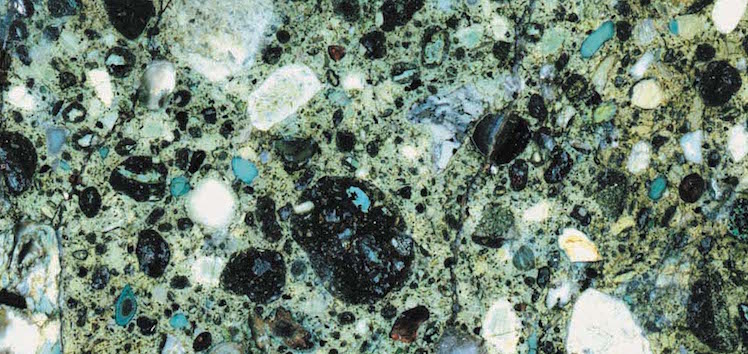Kimberlite

Kimberlite is one of only two igneous rocks found at the surface in Kansas. Extremely rare in the state, igneous rocks form from hot molten magma that pushes up toward the surface from Earth's interior then cools. The magma may cool and harden before reaching the surface or erupt onto the surface. Kimberlite forms in vertical structures in the earth's crust known as kimberlite pipes. The mineral olivine—an olive-green to brown mineral made up of magnesium, iron, and silica—is the main constituent of kimberlite.
Kimberlite is found in only a small portion of Riley and Marshall counties near Tuttle Creek Lake. Lamproite, the other igneous rock in Kansas, is found in a small area along the Woodson and Wilson county line. Although diamonds occur with both kimberlite and lamproite in other parts of the world, none have been found in Kansas.
Thirteen kimberlite pipes have been identified in Kansas—twelve in Riley County and one in Marshall County. At six of the sites, kimberlite was exposed at the surface. At the others, it was buried up to 25 feet underground. To find the kimberlite, scientists flew surveys in which they measured changes in Earth's magnetic field with an instrument called a magnetometer. Because kimberlite contains more magnetic minerals than the surrounding rock, it registered a higher response on the magnetometer.
Resources
Berendsen, P., Weiss, T., and Dobbs, K., (2000), Kansas Kimberlites: Kansas Geological Survey, Public Information Circular.
Buchanan, R., 2010, Kansas Geology: An Introduction to Landscapes, Rocks, Minerals, and Fossils (2nd ed.): Lawrence, Kansas, University Press of Kansas, 240 p.
Buchanan, R., and McCauley, J. R., 2010, Roadside Kansas: A Traveler's Guide to Its Geology and Landmarks (2nd ed.): Lawrence, Kansas, University Press of Kansas, 392 p.
Kansas Rocks and Minerals, Kansas Geological Survey Educational Series 2